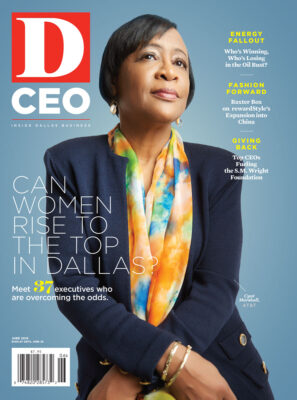Just look around in stores, restaurants, hospitals, startup firms, and professional offices, and it’s clear that women are playing more active if not dominant roles these days in the Dallas-Fort Worth workforce. But what about in the North Texas C-suite, where policies are debated and strategies are set? That’s what the staff of D CEO recently set out to explore.
We found that, although DFW can be an encouraging place for female executives—attorney Marilea Lewis calls it a “strong environment” for them—women in general continue to lag behind men here in compensation, and are woefully under-represented among the area’s business leaders.
Most tellingly, we found that there is not a single woman CEO—not one!—at the region’s top 150 public companies. Women are also largely invisible in the corporate boardroom. While females account for roughly 50 percent of the local population total, they typically make up less than 20 percent of board members at DFW’s biggest public companies. In the specific cases of three of the area’s largest companies, that means just two women each on boards that include 13 members.
Although they’re not limited to DFW, such imbalances are not insignificant, according to Sheryl Skaggs, a Ph.D. professor of sociology in the School of Economic, Political and Policy Sciences at the University of Texas at Dallas. Skaggs’ research shows that, while having one or two women on a board may be nice, at least 55 percent of a board must be female in order for women in the company’s management to thrive. Of hundreds of big U.S. companies that Skaggs has studied, however, only three or four had attained that all-important 55-percent figure.
What’s more, Skaggs also found that having women in executive positions alone “does not seem to matter” in bolstering women’s fortunes at companies in general. That’s because it’s the company boards that call the shots long-term, while C-suite occupants are most apt to be preoccupied with day-to-day operations. Says Skaggs: “It’s not likely that one woman in the C-suite will throw herself on the railroad tracks and make gender a primary policy issue.”
What other workplace issues most concern local women? The top three overall, says Pushkala Raman, Ph.D., an associate marketing professor at Texas Woman’s University, are compensation and leave, training and mentoring, and the organization’s ethics. Raman, who surveyed hundreds of working women (mostly in Tarrant County) about their “ideal workplace” for the Fort Worth Chamber of Commerce, found that younger and minority women were particularly interested in mentoring, especially by members of the same ethnic or racial group.
As the experience of Kimberly-Clark illustrates, these efforts are being undertaken not simply because they’re “fair,” but because they’re also in the long-term best interests of the companies themselves. While women were Kimberly-Clark’s primary customers, females were under-represented in the company’s workforce and C-suite. After CEO Tom Falk set out to make increasing gender diversity his top priority, Kimberly-Clark’s stock price nearly doubled.
It’s hard to say whether there’s a direct cause-and-effect between more diversity and the higher stock price. But Falk’s efforts certainly didn’t hurt. The question on the table now is: Will other North Texas companies follow suit?






